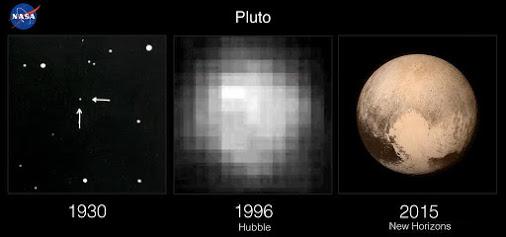
Pluto's Panorama with the Sun far far away imagined in the documentary Universe - via @astroperinaldo

Once upon a time, there was a controversy in particle physics. There were some physicists who denied the existence of structures more elementary than hadrons, and searched for a self-consistent interpretation wherein all hadron states, stable or resonant, were equally elementary. Others, appalled by the teeming democracy of hadrons, insisted on the existence of a small number of fundamental constituents and a simple underlying force law. In terms of these more fundamental things, hadron spectroscopy should be qualitatively described and essentially understood just as are atomic and nuclear physics.(11)
Three quarks for Muster Mark!
Sure he has not got much of a bark
And sure any he has it's all beside the mark.
from Finnegan's Wake by James Joyce

John Philipps Emslie (1839–1913) was a British topographical artist and folklorist.He also realized a lot of scientific illustration, something like the modern infographics. For example the map of the Moon (via core77) at the beginning of the post. The caption of the map was a quotation by William Scoresby about his observation of the Moon at the Lord Rosse's telescope between 1847-48:
From 1854, Emslie studied at The Working Men's College, and was a student of Dante Gabriel Rossetti. He became a topographical artist, and illustrated The Illustrated topical record of London vol. 9. in 1900. He wrote and illustrated the New Canterbury Tales (Griffith, Farran, Okeden & Welsh) ca.1887.
Emslie was an original member of The Folklore Society and was a council member for that Society. He gathered local folklore from around England, making notes and topographical drawings.
It appeared like a Globe of Molten Silver, and every object of the extent of a hundred yards was quite visible. Edifices, therefore of the size of York Minster might be early perceived if they had existed. But there was no appearance of anything of that nature neither was there any in diction of the existence of water or of an atmosphere. There was a vast number of extinct volcanoes, several miles in the breadth through one of them there was a line in continuance of one about 160 miles in length, which ran in a straight direction on like a railway. The general appearance however was like one vast ruin of nature.

In the summer of 1903 my mother presented me with a 2-1/2" astronomical telescope, and thenceforward my gaze was ever upward at night. The late Prof. Upton of Brown, a friend of the family, gave me the freedom of the college observatory, (Ladd Observatory) & I came & went there at will on my bicycle. Ladd Observatory tops a considerable eminence about a mile from the house. I used to walk up Doyle Avenue hill with my wheel, but when returning would have a glorious coast down it. So constant were my observations, that my neck became much affected by the strain of peering at a difficult angle. It gave me much pain, & resulted in a permanent curvature perceptible today to a close observer.(1)Thanks to this passion for cosmos, Lovecraft starting to write The Rhode Island Journal of Astronomy:
In January, 1903, astronomy began to engross me completely. I procured a small telescope, and surveyed the heavens constantly. Not one clear night passed without long observation on my part, and the practical, first-hand knowledge thus acquired has ever since been of the highest utility to me in my astronomical writing. In August 1903 (though I knew nothing of the press associations) I commenced to publish an amateur paper called The R.I. Journal of Astronomy, writing it by hand, and duplicating it on a hectograph. This I continued for four years, first as a weekly, later as a monthly.(1)he wrote in a letter to Maurice W. Moe, on 1 January 1915.